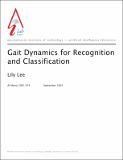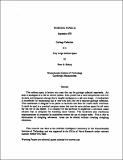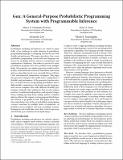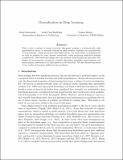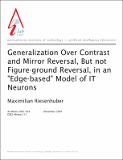Browsing Computer Science and Artificial Intelligence Lab (CSAIL) by Title
Now showing items 1378-1397 of 3804
-
Gait Analysis for Classification
(2003-06-26)This thesis describes a representation of gait appearance for the purpose of person identification and classification. This gait representation is based on simple localized image features such as moments extracted from ... -
Gait Dynamics for Recognition and Classification
(2001-09-01)This paper describes a representation of the dynamics of human walking action for the purpose of person identification and classification by gait appearance. Our gait representation is based on simple features such as ... -
Game Tree Searching by Min/Max Approximation
(1986-09) -
Garbage Collection in a Very Large Address Space
(MIT Artificial Intelligence Laboratory, 1975-09)The address space is broken into areas that can be garbage collected separately. An area is analogous to a file on current systems. Each process has a local computation area for its stack and temporary storage that is ... -
Garbage Collection is Fast, But a Stack is Faster
(1994-03-01)Prompted by claims that garbage collection can outperform stack allocation when sufficient physical memory is available, we present a careful analysis and set of cross-architecture measurements comparing these two approaches ... -
Gasping for AIR Why we need Linked Rules and Justifications on the Semantic Web
(2011-04-16)The Semantic Web is a distributed model for publishing, utilizing and extending structured information using Web protocols. One of the main goals of this technology is to automate the retrieval and integration of data and ... -
A Gaussian Approximation of Feature Space for Fast Image Similarity
(2012-10-01)We introduce a fast technique for the robust computation of image similarity. It builds on a re-interpretation of the recent exemplar-based SVM approach, where a linear SVM is trained at a query point and distance is ... -
Gen: A General-Purpose Probabilistic Programming System with Programmable Inference
(2018-11-26)Probabilistic modeling and inference are central to many fields. A key challenge for wider adoption of probabilistic programming languages is designing systems that are both flexible and performant. This paper introduces ... -
GenBase: A Complex Analytics Genomics Benchmark
(2013-11-19)This paper introduces a new benchmark, designed to test database management system (DBMS) performance on a mix of data management tasks (joins, filters, etc.) and complex analytics (regression, singular value decomposition, ... -
A General Framework for Highly Available Services based on Group Communication
(2000-11)We present a general framework for building highly available services. The framework uses group communication to coordinate a collection of servers. Our framework is configurable, in that one can adjust parameters such as ... -
General Purpose Parallel Computation on a DNA Substrate
(1996-12-01)In this paper I describe and extend a new DNA computing paradigm introduced in Blumberg for building massively parallel machines in the DNA-computing models described by Adelman, Cai et. al., and Liu et. al. Employing ... -
Generalization and Properties of the Neural Response
(2010-11-19)Hierarchical learning algorithms have enjoyed tremendous growth in recent years, with many new algorithms being proposed and applied to a wide range of applications. However, despite the apparent success of hierarchical ... -
Generalization in Deep Learning
(2018-05-01)With a direct analysis of neural networks, this paper presents a mathematically tight generalization theory to partially address an open problem regarding the generalization of deep learning. Unlike previous bound-based ... -
Generalization of the MV Mechanism
(2008-05-01)Micali and Valiant proposed a mechanism for combinatorial auctions that is dominant-strategy truthful, guarantees reasonably high revenue, and is very resilient against collusions. Their mechanism, however, uses as a ... -
Generalization over contrast and mirror reversal, but not figure-ground reversal, in an "edge-based
(2001-12-10)Baylis & Driver (Nature Neuroscience, 2001) have recently presented data on the response of neurons in macaque inferotemporal cortex (IT) to various stimulus transformations. They report that neurons can generalize over ... -
A Generalized Approach to Equational Unification
(1985-08)Given a set of equational axioms and two terms containing function symbols and variables, the equational unification problem is to find a uniform replacement of terms for the variables that makes the terms provably equal ... -
Generalized Conflict Learning For Hybrid Discrete Linear Optimization
(2005-05-20)Conflict-directed search algorithms have formed the core of practical, model-based reasoning systems for the last three decades. In many of these applications there is a series of discrete constraint optimization problems ... -
Generalized Low-Rank Approximations
(2003-01-15)We study the frequent problem of approximating a target matrix with a matrix of lower rank. We provide a simple and efficient (EM) algorithm for solving {\\em weighted} low rank approximation problems, which, unlike simple ... -
A Generalized Ordering Constraint for Stereo Correspondence
(1984-05-01)The ordering constraint along epipolar lines is a powerful constraint that has been exploited by some recent stereomatching algorithms. We formulate a generalized ordering constraint, not restricted to epipolar lines. ...

